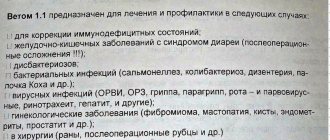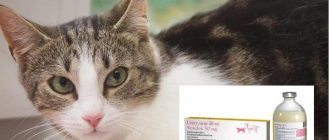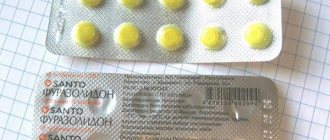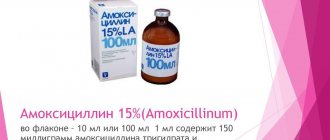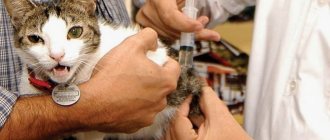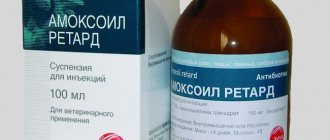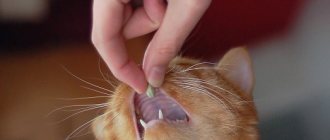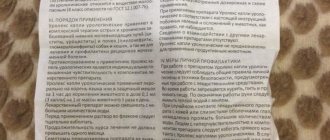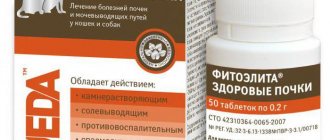COMPOUND
Active substance:
- Feliferon for cats, according to the instructions, 1 ml contains feline interferon with antiviral activity of 400,000 IU as an active ingredient
Excipients:
- dextran-40 50.00 mg
- sodium salt of ethylenediaminetetraacetic acid 0.07 mg
- sodium acetate 1.64 mg
- sodium chloride 5.84 mg
- polysorbate-20 0.10 mg
- glacial acetic acid about 0.0045 ml
- water for injection up to 1 ml
Features of use
The drug is prescribed for the prevention of viral diseases, especially during an epidemic. It is useful in the postpartum period, since the cat’s body is weakened. After surgery, there is a risk of complications, the medicine helps reduce the likelihood of their occurrence.
The instructions for use of Feliferon for cats include the following indications for use:
- hypovitaminosis;
- anemia;
- poisoning;
- diseases of the digestive system;
- helminthiases.
You cannot administer the medicine immediately after vaccination, as it will suppress the effect of the vaccine and prevent the formation of immunity against a specific disease. You must wait ten days and only then use the drug.
Injections are given intramuscularly, dosages are calculated individually. To increase immunity, injections are given twice (once a day), a single dose of 0.5 ml per cat. The same amount of the drug is administered to treat diseases, the average course is 5 days. Feliferon is combined with antibiotics and other medications. In case of severe pathologies, the dose is increased to 1 ml per day, the duration of treatment is about a week.
It is advisable to give injections at the same time, at regular intervals. Do not skip the administration of the drug. Feliferon is not mixed with anything in the syringe. You should not skip the course of treatment, as this reduces the effectiveness of the medicine.
PHARMACOLOGICAL PROPERTIES OF FELIFERON
Pharmacological group: immunomodulators, drugs with antiviral activity. Feliferon for cats has an immunostimulating and antiviral effect.
The mechanism of action consists of:
- increased phagocytic activity of macrophages in cats
- increasing the specific cytotoxicity of lymphocytes
- increasing the resistance of healthy cells of the cat’s body to infection with viruses
- in suppressing the reproduction of RNA and DNA viruses in infected cells
According to the degree of impact on the cat’s body, Feliferon is classified as a low-hazard substance
(grade 4), in recommended doses does not have a skin irritant or resorptive toxic effect.
general information
Feliferon is an immunomodulator and antiviral drug. The active substance is interferon. Available in the form of a colorless solution for injection (sometimes a slight turbidity may be present). The liquid is odorless, packaged in glass bottles, each containing 2.5 ml. The product must be stored in airtight conditions, so each container is closed with a thick rubber stopper and an aluminum lid on top.
Interferon is a protein that the body produces to fight the virus. The drug contains additional components:
- acetic acid;
- sodium chloride;
- purified water and others.
After opening the bottle, the medicine must be used within 5 days. The packaging should be stored in a dry place and away from sunlight. Preferred temperature is 2-8°C.
The mechanism of action of Feliferon is quite simple. The drug enters the body, suppresses the proliferation of infected cells and stimulates increased immunity. The cat’s body begins to resist the disease and produce antibodies that suppress the activity of viruses. Feliferon has no toxic effects and does not cause skin irritation from the injection, so it can be given to animals of any age.
Why use Feliferon to treat cats?
According to the instructions, feliferon is designed for the treatment of viral diseases of cats. Field studies of cats with calicivirus infection have shown a reduction in the severity and duration of clinical signs associated with the virus. The drug has also been used in the adjunctive therapy of cats with infectious peritonitis with uncertain clinical results.
Feliferon for cats has been used experimentally in the treatment of feline viral infections, including leukemia, immunodeficiency and coronavirus infection.
Feline interferon given prophylactically or therapeutically to cats experimentally infected with FIP does not reduce mortality. However, the high-dose protocol resulted in transient suppression of clinical signs and decreased serum antibody titers to FIP with increased survival time (weeks) compared to untreated cats. There are no good studies on the effect of this treatment on spontaneously occurring FIP infection, although one protocol has been described using human interferon alpha 30 IU/day orally for 7 days on alternating weeks for 6–7 weeks.
Feliferon in cats is indicated for the treatment of herpes keratitis.
Trials are currently underway to examine the potential benefits of interferon therapy for feline chronic gingivostomatitis.
Instructions for use of Feliferon
Veterinarians prefer to prescribe the drug we describe in the following cases:
- For acute or chronic diseases of the gastrointestinal tract.
- Feline interferon is very useful for respiratory infections of a viral or bacterial nature (in the latter case, to prevent the accumulation of viral diseases).
- It is recommended to use Feliferon in case of other bacterial, fungal or viral pathologies, since the drug effectively increases the cat’s immunity and helps the animal quickly cope with the consequences of the disease.
- It is useful for hypovitaminosis and even anemia, as it strengthens the defense mechanisms of the pet’s body.
- The instructions for use recommend its use in case of serious poisoning.
- The drug has proven itself very well when used in the postpartum period as a means of reliably preventing the development of secondary infections (especially after difficult, protracted labor).
- Similarly - in the postoperative period. Experts say that the introduction of prophylactic doses of the drug reduces the likelihood of developing postoperative complications by approximately 40%. This is especially true for “dirty” operations associated with the need to operate on inflamed, purulent wounds and other injuries.
- Secondary immunodeficiencies are also treated with feline interferon.
Is Feliferon administered to pregnant cats?
Veterinarians are divided on this issue. But many experts still believe that doing this is risky. There is an opinion that the introduction of any immunomodulators to pregnant cats during pregnancy is fraught with the development of autoimmune pathologies and other disorders associated with the animal’s immune system.
Thus, using the medicine in such cases is an extreme measure due to the impossibility or undesirability of using other medications.
How and where to inject the medicine
So how and where to inject the drug? It is administered only intramuscularly
There are no special subtleties or nuances: it is only important to carefully cut and wipe the area where the drug is injected with a 70% alcohol solution. After the injection, it is useful to massage and rub this area a little in order to better distribute the medicine in the tissues of the animal.
Feliferon dosage
The dosage depends on the goals pursued by the drug:
For preventive purposes, when the owner suspects that his pet has been in contact or may come into contact with sick individuals in the future, the medicine is used in a dose of 200,000 IU (i.e. 0.5 ml). It is administered twice, the interval between applications is two days.
When treating viral or other diseases, the dose is the same, i.e. 200,000 IU, but injections are given every day. The treatment period is exactly a week. The combined use of the drug with antibiotics and other antimicrobial agents, immunoglobulins and serums is allowed, but before this, consultation with an experienced veterinarian is necessary.
If the disease is severe and the animal’s condition is in doubt, then a milliliter of the drug (400,000 IU) is administered at a time. The treatment period can be increased to two weeks.
The drug must be used in accordance with the timing and dosage of administration. Even a single omission of administration of the drug is fraught with a serious decrease in its therapeutic effect. In such cases, it is necessary to repeat the administration of the drug as soon as possible, trying to keep the interval between doses as short as possible. Some experts in such situations recommend increasing the dose by about 50,000 IU.
Contraindications when using Feliferon
The only significant factor limiting the widespread use of the drug is the individual intolerance of the animal to its components. However, there are other contraindications. In addition, we have already indicated above that it is not recommended to use it until ten days have passed from the date of any vaccination.
Finally, experienced veterinarians believe that it is extremely undesirable to prescribe Feliferon in the following cases:
- The animal's predisposition to various allergic reactions.
- In the long term, it is dangerous to prescribe feline interferon for autoimmune diseases of any origin (the drug can worsen the animal’s condition).
If, after administration of the drug, the animal experiences symptoms of an allergic reaction, the use of the drug should be stopped immediately and the cat should be given symptomatic therapy in the form of antihistamines.
INDICATIONS
Feliferon is prescribed to cats according to the instructions for use for therapeutic and prophylactic purposes for:
- feline herpesvirus (rhinotracheitis)
- panleukopenia
- calicivirus
- anemia and hypovitaminosis
- in the postoperative period
- in the postpartum period
- secondary immunodeficiency
- gastrointestinal
- invasive diseases
- acute respiratory
- poisoning
- other diseases of viral or mixed etiology
Instructions for use of Feliferon
Feliferon is prescribed for the prevention of viral infections, as well as as part of therapy for the following groups of diseases:
- viral infections of the gastrointestinal and respiratory tract;
- hypovitaminosis;
- poisoning;
- anemia;
- helminthic infestations.
The instructions for use indicate that it can increase the body's resistance to the penetration of infectious agents in the postoperative and postpartum period.
How and where to inject
When using the drug yourself, you should know exactly how and where to inject it to ensure maximum effectiveness.
Feliferon is injected intramuscularly to a depth of 1-1.5 cm into the hind limb. During injection, the needle should be directed at an angle of 450, and it should not rest against the bone.
Before the injection, it is necessary to palpate the muscle to determine its volume. This will prevent the needle from being inserted too deeply. The fact is that the periosteum is the most sensitive tissue in the body. Therefore, even a light touch to it can cause a painful shock.
Feliferon dosage
If the cat has been in contact with an infected animal, then for preventive purposes the veterinarian may prescribe 2 injections with an interval of 48 hours. The dosage will be 200,000 IU, regardless of the pet’s weight.
Knowing that 1 cm3 contains 400,000 IU, and a bottle contains 2.5 cm3, it is easy to calculate that you need to take 0.6 cm3 of the drug for 1 injection.
For therapeutic purposes, Feliferon is administered in the same dose 1 time per day for 5-7 days in combination with other medications that affect the causes and symptoms of a particular disease.
During a severe form of the disease, the doctor may decide to double the daily dose. The presented product must be injected at regular intervals.
Contraindications for use
Feliferon should be used only as prescribed by a veterinary doctor after a clinical examination and diagnosis.
Contraindications to its use are:
- any manifestations of allergic reactions (rashes, tearing, swelling, redness, difficulty breathing);
- autoimmune diseases;
- the first 10 days after vaccination.
Prescription of Feliferon for pregnant cats
Bearing offspring is not a direct contraindication to the use of the medicine, but a sharp increase in immunity can cause a miscarriage in a pregnant female.
Based on this, the doctor must decide on the advisability of administering interferon, having foreseen and assessed in advance all the consequences of this manipulation.
Side effects
If the dosage and rules for administering Feliferon were followed, no side effects were recorded. If the cat shows individual intolerance to the solution, then its use should be stopped and the animal should be given an antihistamine.
Storage conditions
To preserve the healing properties of Feliferon solution, the drug must be stored correctly. The medicine in its entire packaging is stored in a place out of direct sunlight. The packaging of the drug is not placed together with food products. Also, the product should be stored out of the reach of children. Vials with the drug should be located in a place where the temperature is maintained from 2 to 8 degrees above zero.
The solution can be frozen once at a temperature not lower than 25 degrees. The shelf life of the drug is 24 months, subject to storage conditions. The solution in an opened bottle is stored for no more than 5 days. It is prohibited to treat an animal with expired Feliferon. Unspent remains of the drug are disposed of in accordance with the standards for neutralization of pharmacological products.
MODE OF APPLICATION
Feliferon solution for injection is administered intramuscularly to cats. If there is a threat of infection, the drug is prescribed at a dose of 200,000 IU per animal, twice with an interval of 48 hours. For the treatment of cats with viral, bacterial and mixed diseases, Feliferon is administered in a daily dose of 200,000 IU, for 5-7 days in combination with antibiotics, serum and immunoglobulin preparations, in accordance with the instructions for their use.
In severe cases of the disease and mixed infections, it is recommended to increase the average therapeutic dose by 2 times - 400,000 IU.
No overdose symptoms have been identified when using the drug. Avoid missing the next dose of Feliferon in cats, as this may lead to a decrease in therapeutic effectiveness. If one dose is missed, it is necessary to administer it to the cat as soon as possible, then the interval between administrations of the drug does not change.
How to use
Feliferon injections for cats, according to the instructions for use, are given intramuscularly. The dosage and regimen of use depends on the pathology and the degree of its development:
- If there is a threat of infection, injections are given to strengthen the immune system twice with an interval of 48 hours. A single dose is 200,000 IU or 0.5 ml per animal.
- If an immunostimulant is used in the treatment of bacterial, viral and other diseases, it is administered at a dose of 0.5 ml per day. The duration of treatment is usually 5-7 days. In this case, the drug is combined with antibiotics, antiviral drugs, as well as medications whose action is aimed at eliminating symptoms.
- If the disease is severe, the daily dose may be doubled, that is, up to 1 ml. The duration of treatment is about a week, but usually the course is determined by the doctor on an individual basis.
It is recommended to administer the drug at approximately the same time and at regular intervals. It is advisable not to miss the next dose of medication. If the injection was not given on time, you need to return to treatment as soon as possible. In this case, there is no need to make changes to the treatment regimen.
Note! It is prohibited to mix an immunomodulator with other medications in the same syringe.
Prevention measures:
If allergic reactions occur or if the drug accidentally enters the human body, you should immediately contact a medical facility (bring the instructions or label with you).
People with hypersensitivity to the components of the drug should avoid direct contact with the drug. When working with Feliferon for cats, you should follow the general rules of personal hygiene and safety precautions provided for when working with medications.
If a person accidentally comes into contact with the medicinal product with the skin or mucous membranes of the eyes, they must be rinsed with plenty of running water.
Empty drug bottles must not be used for household purposes; they must be disposed of with household waste.
Precautions and special instructions
When working with Feliferon, you must remember the following:
- Do not mix the drug with other medications in a syringe;
- not used for the treatment of productive animals;
- after using the medication, wash your hands thoroughly with soap;
- if Feliferon comes into contact with the skin or mucous membranes, rinse the area of contact with running water;
- If contact of the solution with the skin causes an allergic reaction, you must seek qualified help from a doctor, being sure to take the instructions for the drug.
Learn about essential antimicrobials in animals
- Trichopolum instructions for veterinary medicine
- Instructions for the use of the antibiotic Baytril in animals
- Instructions for use of metronide
- Instructions for ceftriaxone preparations for animals
- Use of Metrogyl in veterinary medicine
- Instructions for doxycycline in animals
- Metronidazole (Metronidazole) for animals (instructions for use in veterinary medicine, doses, indications and contraindications)
- Atovaquone (ATOVAQUONE)
- Azithromycin, instructions for animal therapy
^Top
